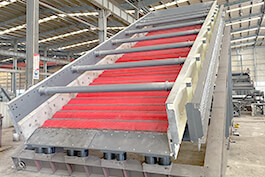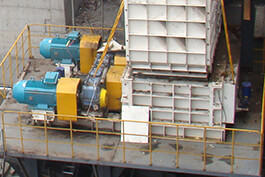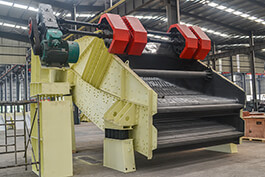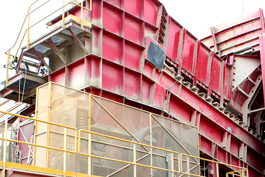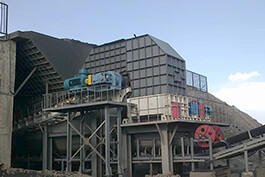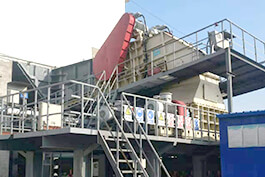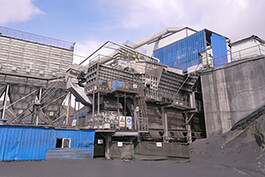Working principle and characteristics of the Flip flow screen
The Flip flow screen uses polyurethane rubber as the sieve surface. Under the control of a dual-mass vibration system, the two adjacent crossbeams supporting the sieve surface belong to two vibration masses. One of the masses is the sieve box, and the other is the counterweight. When the two masses have a phase difference of w and vibrate, the two adjacent crossbeams approach each other at times and move away from each other at other times. The elastic sieve surface also becomes looser at times and tighter at other times, that is, the sieve surface moves along with the sieve box in a dragging motion while also moving relative to the sieve box. This relaxation movement not only causes the sieve holes to continuously deform but also increases the vibration intensity of the sieve surface, thereby effectively overcoming the phenomenon of sieve hole blockage and significantly improving the processing capacity of the screening machine.
Four factors affecting the screening effect of Flip flow screen
Amplitude of Flip flow screen
The size of the amplitude directly determines the vibration amplitude of the materials during the screening process. This vibration amplitude will significantly affect the screening efficiency and final effect. If the amplitude is too large, the materials may be unable to be effectively separated due to excessive vibration; conversely, if the amplitude is too small, the materials may not be able to fully contact the screen surface, also affecting the screening effect. Therefore, in order to ensure the best screening effect, the amplitude must be precisely adjusted according to the specific characteristics of the materials and the screening requirements.
Width of the screen surface of Flip flow screen
The width of the screen surface directly determines the size of the screening area, and thereby affects the throughput of the materials and the screening speed. If the screen surface is too narrow, the screening area is insufficient, resulting in limited material throughput and low screening efficiency; while if the screen surface is too wide, although it can improve the screening efficiency, it may also increase the manufacturing cost and operating energy consumption of the equipment. Therefore, when choosing the width of the screen surface, it is necessary to consider the screening requirements and cost control comprehensively.
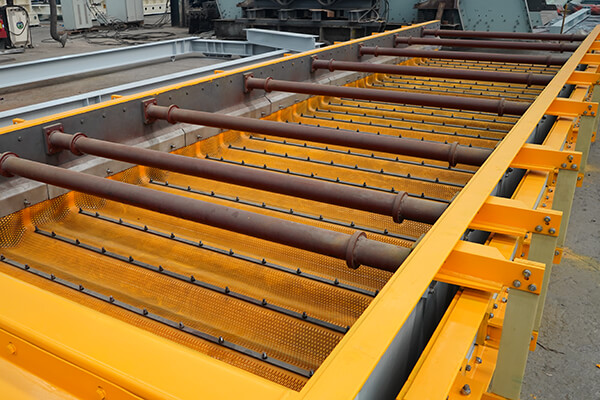
Tension of the screen surface
The reasonable control of tension has an important impact on the service life and screening accuracy of the screen surface. If the tension is too large, the screen surface is prone to excessive stress during vibration, leading to cracking and shortening of the service life; while if the tension is too small, the screen surface will be loose and unable to maintain stable screening accuracy and efficiency. Therefore, it is necessary to adjust the tension appropriately according to the material's material and actual usage conditions to ensure the stability and durability of the screen surface.
The high or low speed of the rotation directly relates to the movement speed of the materials on the screen surface and the screening time. An appropriate rotation speed can make the materials evenly distributed on the screen surface, improving the screening efficiency; however, if the rotation speed is too fast, the materials may not be effectively screened due to excessive centrifugal force; conversely, if the rotation speed is too slow, the screening time will be too long, affecting production efficiency. Therefore, in actual operation, the rotation speed should be optimized and adjusted according to the material's characteristics and screening requirements to achieve the best screening effect.
Features of Flip flow screen
1) The Flip flow screen uses the principle of sub-resonance to achieve vibration, so the power demand of the equipment is relatively small. The Flip flow screen has no complex mechanical transmission devices and is compact in structure. Although the surface acceleration of the sieve face can reach 50g, the impact load on the foundation from the vibration of the sieve body is much less than that of traditional screening machines. The floating bed of multiple layers or more layers is driven by elliptical vibration, and the vibration amplitude of the floating bed of the Flip flow screen is much greater than that of traditional vibration equipment. This effectively solves the problems of blocked sieve plates and low screening efficiency. It can efficiently process materials with a viscosity and difficulty in screening, such as those below 6mm.
2) The Flip flow screen has a fast feeding and discharging speed and a thin material layer, which results in a high material screening rate and processing capacity. Due to the low inclination angle of the discharge end sieve face, the material movement speed is slow, and the remaining material below the sieve can be completely screened during this process, achieving a very high screening efficiency. According to the inherent regularity of the material flow, the Flip flow screen can effectively loosen, stratify and screen the wet and sticky material layer. The structure of the Flip flow screen is simple, requiring only one motor for drive, and the overall weight of the screening machine is light, with low energy consumption, stable and reliable operation, low failure rate, less daily maintenance, low noise during operation, and long service life.
3) The linear motion mode of the box-type exciter ensures high reliability and simple daily maintenance with low cost.
4) The side part of the screening machine uses U-shaped design to form a sealed environment, reducing the wear rate of the side plates and effectively preventing the material on the sieve from entering the sieve below.
5) The sieve plate is fixed by wedge-shaped rubber strips, without any bolts, making disassembly and assembly during maintenance convenient and fast.
The differences and advantages of Flip flow screen compared to other screening machines
The driving method used by ordinary vibrating screens is that the exciter drives the screening machine to move. In contrast, Flip flow screen adopts a mechanical driving method, which ensures the stability of the amplitude under different working conditions. The actual operation situation on site shows that although Flip flow screen can still operate smoothly when the processing capacity is temporarily increased, the situation where Flip flow screen has no amplitude due to the increase in processing capacity has been effectively avoided. Since the motion mode does not use crankshaft transmission, Flip flow screen becomes a "oscillation" in the direction of the screening surface. Compared with the side plates of the screening machine driven by the exciter, which are prone to stress concentration, the side plates and cross beams of Flip flow screen are subjected to more uniform force, thus fundamentally reducing the phenomenon of cracking of the side plates or cross beams of the screening machine and improving the reliability of Flip flow screen operation.



.jpg)
